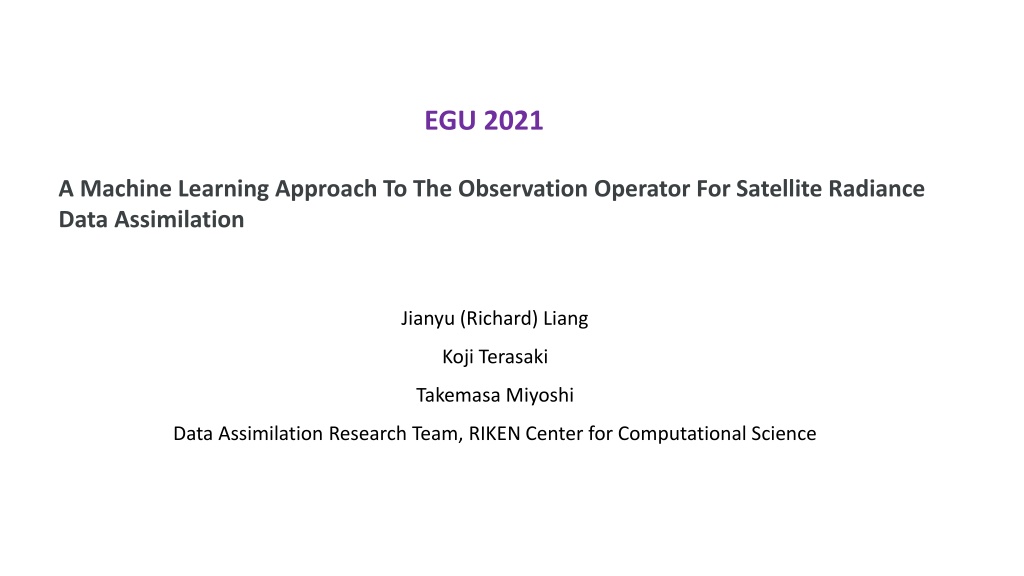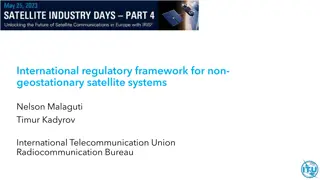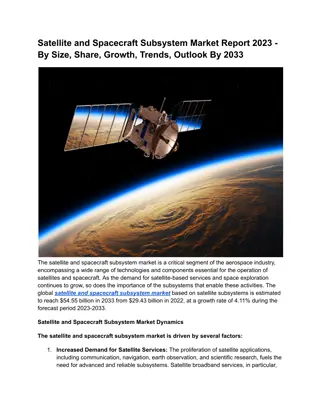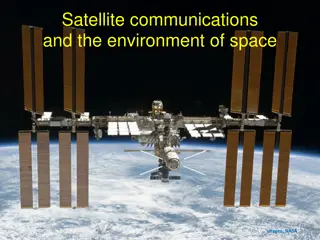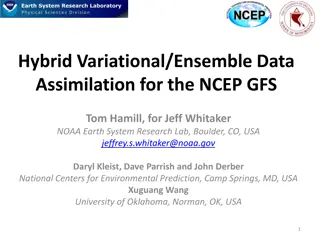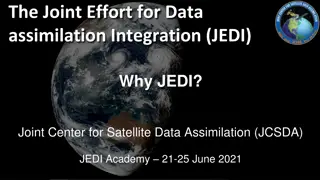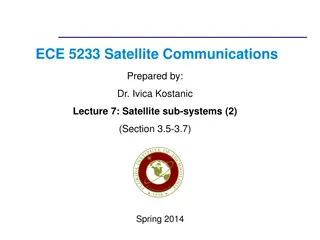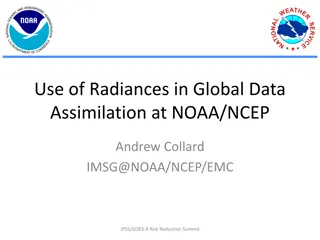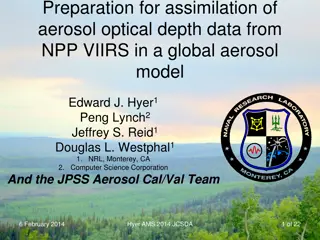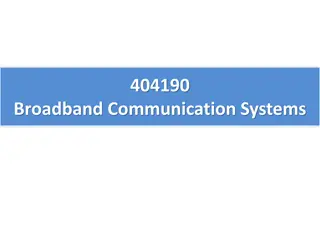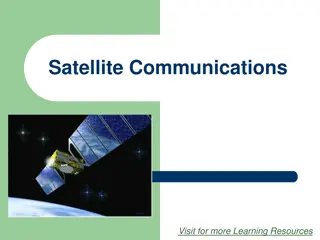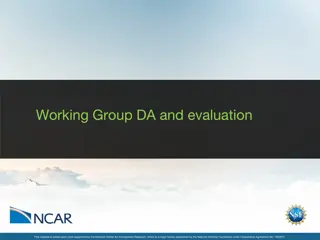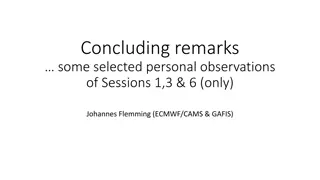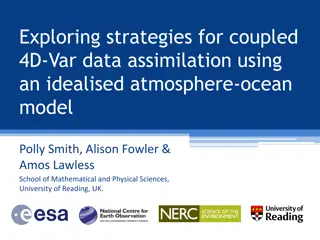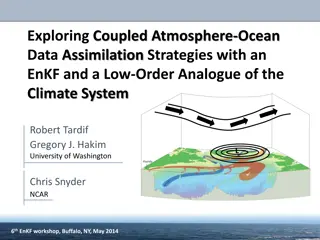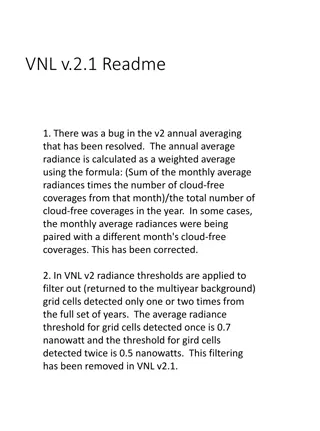Machine Learning Approach for Satellite Radiance Data Assimilation
This research explores using machine learning as the observation operator for satellite radiance data assimilation, aiming to improve the efficiency of the process. By training the machine learning model with model output and observations, the study investigates reducing the need for a physically-based observation operator like RTM (Radiative Transfer Model). Advantages include simplified bias correction and flexibility for different observations, but challenges remain in data requirements and model updates. Overall, the study showcases a novel approach in enhancing data assimilation systems for atmospheric models.
Download Presentation

Please find below an Image/Link to download the presentation.
The content on the website is provided AS IS for your information and personal use only. It may not be sold, licensed, or shared on other websites without obtaining consent from the author. Download presentation by click this link. If you encounter any issues during the download, it is possible that the publisher has removed the file from their server.
E N D
Presentation Transcript
EGU 2021 A Machine Learning Approach To The Observation Operator For Satellite Radiance Data Assimilation Jianyu (Richard) Liang Koji Terasaki Takemasa Miyoshi Data Assimilation Research Team, RIKEN Center for Computational Science
Data assimilation Data assimilation (DA) is the combination of model and observations ??= ??+ ?(? ?(??)) e.g. radiance K: weight matrix ??: analysis (optimal estimate) DA gives the optimal estimate of the initial condition of the model Y: Observations ??: Model simulations e.g. pressure, temperature Adapted from RIKEN we need an observation operator (satellite simulator) H, to take the difference between model variables and observations radiance e.g. pressure, temperature radiance ?(??) : Model equivalent of the observations compare y: Observations ??: Model simulations
Review observation operator (satellite simulator) Current observation operator (RTM: RTTOV) < ? ? > 0 Let ? = ? + ?????+ ??+ ?=1 < ? ? > = 0 It usually takes time to build observation operator and start using the new data after launching the satellites. ? ????(?) ?(??) : Model equivalent of the brightness temperature ??: Model simulations H() : RTTOV and bias correction Use machine learning (ML) as the observation operator < ? ??(?) > = 0 Run a DA experiment using the model output and observations to train the machine learning model ??: Model simulations (1) Training y: Observations (2) Testing, DA experiment ?(??) : Model equivalent of the brightness temperature compare ??: Model simulations y: Observations H(): Machine learning model
Use machine learning as observation operator 1. 2. In this research, physically-based observation operator (RTM) is used to train the machine learning model We are currently considering other methods to train the ML model without using the RTM Advantages: 1. No separate bias correction procedure 2. No explicit coding of the physically-based model 3. Similar infrastructure can be used for other observations so we can use them quickly Disadvantages: 1. need a lot of data to train the ML model 2. need to re-train the ML model if the configuration of the numerical model is changed 3. need to update the ML model regularly using the most up-to-date data
Data assimilation system Non-hydrostatic icosahedral atmospheric model (NICAM) 112 km horizontal resolution and 78 vertical levels up to 40 hPa RTTOV is the observation operator for radiance data assimilation biases are corrected adaptively Local ensemble transform Kalman filter (LETKF) Assimilate conventional observations and satellite radiance every 6 hours 64 members
Radiance data Brightness temperatures (BT) from the Advanced Microwave Sounding Unit (AMSU-A) on NOAA-15, NOAA-18, NOAA-19, METOP-2,and METOP-1 satellites. 2~3 channels were used. Selected channels of AMSU-A. The value is the standard deviation of the observation error. The empty cells indicate that the corresponding channels are not assimilated. Channel NOAA-15 NOAA-18 NOAA-19 METOP-1 METO-2 6 7 8 0.3 0.3 0.3 0.3 0.3 0.3 0.3 0.3 0.3 0.3 0.3 0.3 AMSU-A radiances during a 6-h period before thinning The thinning distance is 250 km
Experiments Training Testing Jan 2015 (DA spin-up) Feb 2015 (DA cycle) Jan 2016 (DA spin-up) Feb 2016 (DA cycle) CONV_AMSUA_ RTTOV conv + radiance(RTTOV) + bias correction conv + radiance(RTTOV) + bias correction conv + radiance(RTTOV) + bias correction CONV_AMSUA_ ML (1) generate the training data (2) Build the ML model conv + radiance(ML) CONV conv conv
Machine learning ? = ????+ ? < ? > = 0 select every 2 points Interpolate model variables at the model grids to observation locations NOAA16 NOAA15 location4 location2 location3 location1
Machine learning 3D variables: pressure (78 levels) temperature (78 levels) specific humidity (40 levels) 2D variables: surface pressure surface temperature 10-meter u-wind and v-wind 2-meter temperature 2-m specific humidity other bias predictor: Satellite zenith angle, Scan angle, latitude Hidden layers Output layer ? = ????+ ? < ? > = 0 Output: y Input: ?? satellite brightness temperature from channel 6, 7, 8 205 features, includes different levels Input layer Hyperparameters: activation function: ReLu learning rate: 1e-04 l2 weight: 1.0e-6 batch size: 512 The training data has around 3 million rows for a 1-month period 350 205
The input features of the machine learning model feature order 1-78 79-156 157-196 197 198 199 variables pressure (log of Pa) temperature (K) specific humidity (kg kg-1) surface pressure (log of hPa) surface temperature (K) 10-m zonal wind (m/s) features order 200 201 202 203 204 205 variable 10-m meridional wind (m/s) 2-m temperature (K) 2-m specific humidity Inverse cosine of satellite zenith angle scan angle (degree) latitude(d egree)
Analyze bias Bias is well handled by machine learning 1 month average Bias = -0.11 K (b) (a) Bias = -0.4 NOAA-18 METOP-2 Bias = 0.01 (c) (d) brightness temperature difference (ML obs )[K] brightness temperature [K]
Temperature and zonal wind compared to ERA Global average of temperature (K) at 500 hPa Spread (b) (c) (a) Bias RMSD Global average of zonal wind (m/s) at 500 hPa RMSD (d) Bias Spread (e) (f)
Temperature and zonal wind compared to ERA 1 month average Global average of zonal wind (m/s) Global average of temperature (K) (b) (a) RMSD (d) (c) Bias (f) (e) Spread
Summary 1. using machine learning as an observation operator to assimilate satellite brightness temperature works well. machine learning can consider the bias and a separated bias correction procedure is not required. We are working on to improve the machine learning model. We are currently considering other methods to train the ML model without using the RTM. 2. 3. 4.
